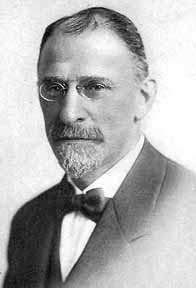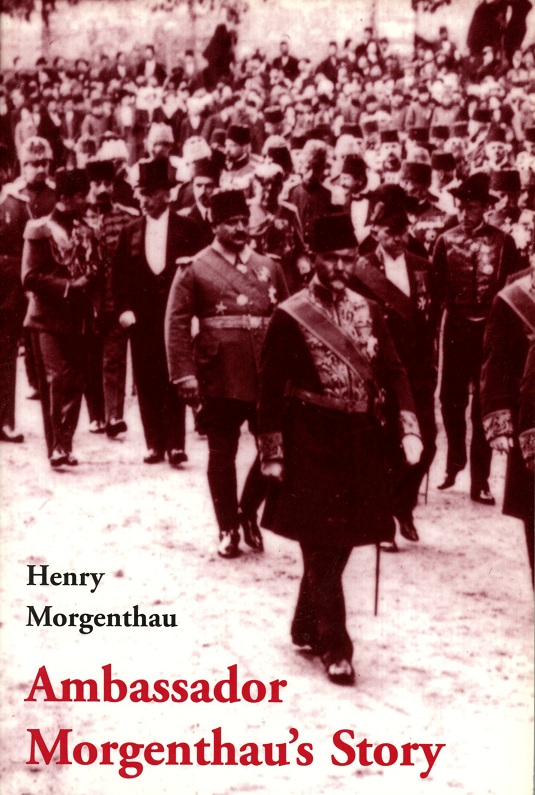Henry Morgenthau was United States ambassador to Ottoman Turkey between 1913 and 1916. In 1914 he witnessed the Ottoman entry into World War I and the genocide of the empire's Armenian population. Ambassador Morgenthau's Story was an indictment against the Ottoman leaders for their entry into the world conflict and the mass murder of over a million Armenians. His account was written with the authority of a firsthand observer and remains one of the classic accounts of World War I.
Ambassador Morgenthau's Story is published as part of the Gomidas Institute Armenian Genocide Documentation Series, alongside American Diplomacy on the Bosphorus: The Diaries of Ambassador Morgenthau, the systematic collection United States Diplomatic and Consular Records on the Armenian Genocide, and the British classic The Treatment of Armenians in the Ottoman Empire, 1915 (uncensored edition).
Cover photo: Henry Morgenthau (in white tie and top hat) talking to Enver Pasha, the Minister of War, at the funeral of German ambassador Hans Wangenheim, Constantinople, 1915. Walking a few steps immediately ahead is Talaat Pasha, the Minister of Interior. Credit: Library of Congress, Henry Morgenthau Senior Collection.
EDITOR'S INTRODUCTION
In November 1917 Henry Morgenthau asked U.S. President Woodrow Wilson and Secretary of State Robert Lansing for permission to publish his memoirs. Morgenthau had been the United States ambassador to Constantinople between 1913 and 1916 and wanted to write about his experiences in the Ottoman capital. Following President Wilson's approval, Morgenthau signed a contract with Double-day, Page and Company and began work on his proposed manuscript. Most of the details in his subsequent work came from his diaries and official correspondence from that period and benefited from hindsight. When writing his memoirs, Morgenthau also had the support of aides and advisers such as Lansing, Burton Hendrick (Doubleday, Page and Company editor), and Arshag Schmavonian (former dragoman of the United States Embassy in Constantinople).
Morgenthau's memoirs were first serialized in World's Work between May 1918 and January 1919 and syndicated in over two dozen newspapers. They were also published in book form under two different titles, Ambassador Morgenthau's Story and Secrets of the Bosphorus. The principal themes of Ambassador Morgenthau's Story were: German preparation for World War I; Ottoman entry into the world conflict; the impact of the war on the Ottoman state; and the genocide of Ottoman Armenians.
Morgenthau reported that in July 1914 there had been a secret meeting in Germany between members of the German armed forces, diplomatic corps, and industrialists to prepare for a European war. This information came from the German ambassador in Constantinople, Hans von Wangenheim, who attended the meeting. Wangenheim's behavior changed as he worked to coax Ottoman leaders into war on Germany's side. Morgenthau was not the only foreign dignitary informed of German plans. Lewis Einstein, a special agent to the U.S. Embassy in Constantinople, was also given similar information by the Italian ambassador, the Marquis Garroni. The latter, too, was informed by Wangenheim.
Ambassador Morgenthau's Story narrates the piecemeal manner in which the Ottoman Turks slid into World War I. One of the key episodes in this development was the passage of two German cruisers, the Breslau and the Goeben, into the Bosphorus in August 1914. These ships (with their crew) were technically transferred to the Ottoman navy, renamed the Yavuz Sultan Selim and the Midilli, and used in the Ottoman entry into World War I. Morgenthau gives fascinating insights into the subsequent period with the destruction of the Ottoman navy, the Allied landings at Gallipoli, and the threat to Constantinople. At one point the Ottoman government even prepared to abandon its capital and move to Asia Minor.
The most disturbing chapters in Ambassador Morgenthau's Story are those dealing with the genocide of Armenians. Morgenthau actively opposed the Ottoman government's destruction of the empire's Armenian population. He was informed of developments in the interior provinces by United States consular officials and had no hesitation in calling the persecutions "race extermination." At one point, Talaat Pasha, the Ottoman Minister of Interior, even admitted to Morgenthau that, "No Armenian can be our friend after what we have done to them." On another occasion Morgenthau disclosed how Talaat Pasha asked for a list of Armenian policy holders in American life insurance companies so that the Ottoman government could cash in their policies. Talaat told the American ambassador that the Armenians in question were "practically all dead" and had no heirs to collect the money. Indeed, the Ottoman government approached foreign insurance companies on this matter and requested lists of Armenian policy holders in provinces where Armenian communities had been destroyed the previous summer. The list of provinces covered both European and Asiatic parts of the Empire: Rodosto, Adana, Djebel-i Bereket, Kozan, Yozghad, Angora, Erzeroum, Bitlis, Aleppo, Antalia, Gemlik, Biledjik, Sivas, Merzifon, Tokat, Samsoun, Ordou, Trebizond, Konia, Mamuret-ul Aziz, Ismid, Adapazar, Sivri Hissar, Eski Shehir, Caesarea, Develi, Nigde, Afion Karahissar, and Ourfa.
Morgenthau disclosed that the Minister of Interior once even admitted to be in possession of (confidential) American diplomatic correspondence regarding Armenians. Indeed, Leslie Davis, the American consul at Mamuret-ul-Aziz, in one of the central theaters of the Armenian genocide, formally notified the State Department that his correspondence was being intercepted by Ottoman officials. This was the environment in which Morgenthau had to work and Ambassador Morgenthau's Story was enacted.
The present publication of Morgenthau's memoirs has been taken from the first edition (1918) of Ambassador Morgenthau's Story. The original text has been reformatted and silently edited for typographical errors. Only diagrams integral to the original narrative have been reproduced, and a new index has been added for the use of readers.
Ara Sarafian
, Princeton, New Jersey January 2000


